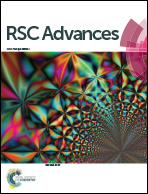Green synthesis of gold nanoparticles and its application for the trace level determination of painter's colic†
Abstract
The green synthesis of metal nanoparticles is found to be more attractive in various disciplines, including analytical chemistry. The present study demonstrates a selective voltammetric determination of painter's colic (lead poisoning) using green synthesized gold nanoparticles (Au-NPs) modified glassy carbon electrode (GCE). The Au-NPs were synthesized by the reduction of chloroaurate ions with the fresh leaf extract of Justicia glauca. The formation of Au-NPs was confirmed by UV-visible spectroscopy using surface plasmon resonance. The average size of the synthesized Au-NPs is found to be 32.5 ± 0.25. A good cathodic response current was observed at the Au-NPs modified electrode, whereas the unmodified electrode does not show any response in the presence of Pb2+. With optimum condition, the Au-NPs modified electrode exhibits a good response towards Pb2+ with a linear response range from 0.005 to 800 μM L−1 and the lowest detection limit of 0.07 nM L−1. The fabricated sensor exhibits a high selectivity towards Pb2+ in the presence of 100 fold concentrations of other metal ions. In addition, the proposed sensor also shows a good practicality towards Pb2+ in river water samples.


 Please wait while we load your content...
Please wait while we load your content...